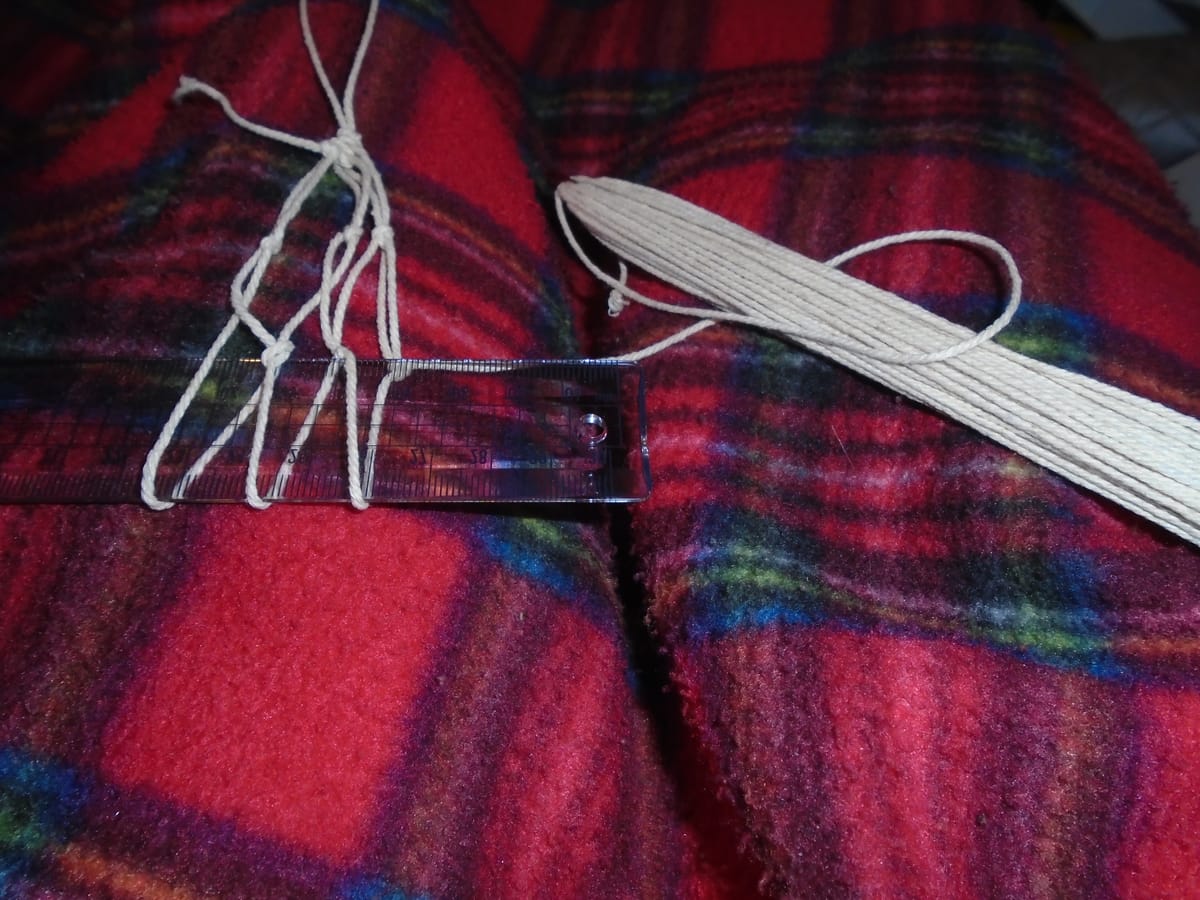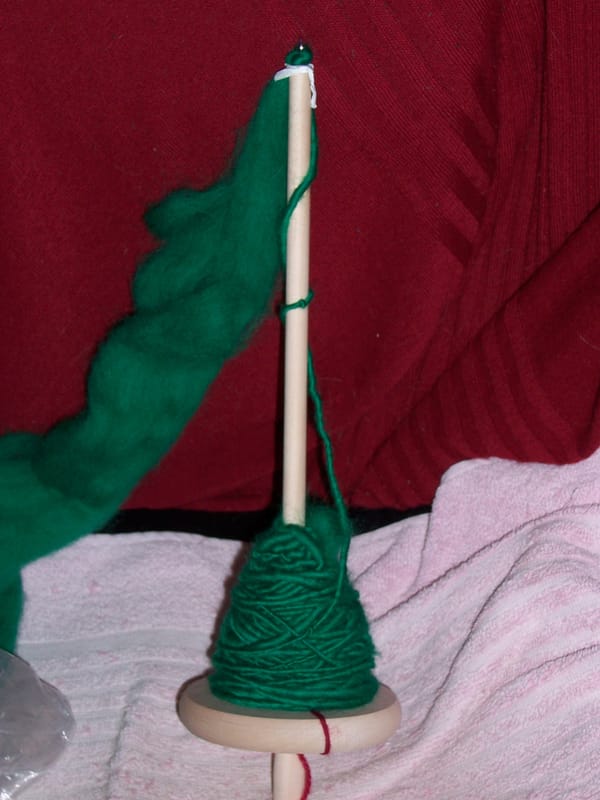Net benefits

So... the knitting is going like gangbusters; Gisele is being painted (she and all her accessories have now had their first coat of Payne's Grey, which for those who don't know is very nearly black, and I shall be going over that with silver to give a kind of gunmetal effect); there's a beading dish drying out in the kitchen, because air-drying clay takes ages, and I am seriously tempted to stick it in the microwave; most of my sewing kit has arrived; and... there's this.
I have made netting before, but it was a very long time ago, probably the early 90s or even the late 80s. So, not surprisingly, I'd almost forgotten how to do it. Almost, but not quite; I knew that "tie a knot" was not a sufficient instruction. There's a netting knot, and that is what you use. I also remembered that, as well as a netting needle, you need a gauge (often called a mesh stick) to keep your meshes nice and even. I did an extensive web search, and you would be truly amazed how many terrible tutorials I found out there. Many of them were clearly using a different technique from the one I'd learnt, which would not have been a problem if they'd explained exactly how it worked; there was at least one that appeared to use some kind of backing fabric, but it didn't say how, and there were no illustrations. Then there was one that seemed to be telling you to lay down an arrangement of loose strands and then "knit the net"; this time there was an illustration, but it showed a netting needle being held over a finished piece of net, which didn't really tell you anything. Perhaps there are better tutorials on YouTube. I have no idea; I didn't look. I am, as you're aware by now, constitutionally allergic to video tutorials. I want to be able to look at what I'm about to do for as long as necessary without constantly hitting Pause, I want text, and if necessary I want to be able to skip back a little to make absolutely sure I've understood correctly.
Once again, the Internet Archive came to the rescue, in the form of a little book by an American gentleman (almost certainly now deceased) named Charles Holdgate. The book was written in the early 1970s; it is simply called Net Making. Mr Holdgate starts out by bemoaning the fact that little boys are no longer in the habit of carrying bits of string in their pockets, as they were forty years previously; proceeds to get very enthusiastic about string; and then launches into what turns out to be an extremely well-written course with clear illustrations. It's perfect as a refresher, and it will equally well teach the absolute beginner in very short order.

I chose to show you this particular page because it has a drawing of the type of netting needle I used to use. Mine was blue plastic; I don't recall exactly how wide it was, but it was something of the order of 2 cm. (As you see, Mr Holdgate, being American, thought in inches, so I do have to convert everything, which is the only slight fly in the ointment regarding an otherwise excellent little book.) And, until very recently, I thought this was the only type of netting needle available, and consequently always wondered how it was possible to make fine-gauge netting. I was most delighted to discover that this was not, in fact, the case. In the feature photo you can just barely see a little of my largest new netting needle, since it's heavily wound with string; these ones are made by Pony, they're metal, and they are very simple. They consist of a long shaft with a pair of flat metal flanges on each end with a space between them. The tops of the flanges are very close together, so you can pull a length of thread between them if you use a little gentle force, but it won't come unwound on its own. Effectively, it's like a very thin weaving shuttle, and indeed netting needles are sometimes referred to as "shuttles". The smallest of my netting needles is 10 cm long and will take very fine thread, so it is perfect for making net for filet work... which is what I wanted them for. (The large one will make things like string bags, or the football carrier detailed in the book; I'm sure I know plenty of children who play football!)
Mr Holdgate starts out by teaching you to tie a netting knot, without the needle at first; and he tells you something I was never told when I originally learnt, which is that a netting knot is the same thing as a sheet bend. Or a weaver's knot. That knot can be tied in a variety of different ways, but what makes it specifically a netting knot is how you tie it. Once you're confident at doing that ("ah, yes," I thought, "now it all comes back!"), he gets you making a small practice piece of netting, which is what I've shown in the feature photo. I did take it off its anchor to photograph it. The foundation loop (top of photo) goes over a hook or peg while you're working. I happen to have a trolley next to my chair with a pair of risers at each end to hold the trays in place, and these risers protrude a little way from the top, so they are extremely convenient for hooking things over (my camera hangs permanently from one of these risers when not in use). However, I couldn't both stretch it out on the anchor and take a photo at the same time, so I compromised.
The technique is really simple. Essentially, your working thread goes down over the front of your gauge (in this case a small folding ruler, which was the most convenient object I had that was about the right width), then up at the back of the gauge and through the loop above. You pull it up till the bottom of the loop above is resting on the top of the gauge, hold it in place with your thumb, tie your netting knot, and repeat along the row of loops. Mr Holdgate has a sequence of drawings to show you how to do it, so even someone who's convinced they're all thumbs is not going to get stuck. That teaches you the basic technique, and then in the very next project you're into grommets, which I've never even done before. (A grommet, in this context, is a loop of thread that's used as a centre for a series of meshes; for instance, if you were making a net to hold a hanging basket, you'd probably start with a grommet.) This is why I plan to work through the whole course using string; I don't need things like grommets for making a flat piece of fine-gauge netting to do filet embroidery on, but it's already clear that the course is going to expand my net-making skills in general, and the more you expand your craft skills, the more uses you find for them. As if I wasn't more than busy enough already.
Oh, and the other nice thing? Just about all the netting tutorials online at the moment assume you're planning to go fishing. Mr Holdgate makes no such assumption. Yes, he's got a design in there for a crab pot, but it's just one of many items, because netting is so much more versatile than just something with which to catch fish. Or crabs. It makes it a lot easier to forgive him for assuming that the craft will primarily appeal to small boys!




